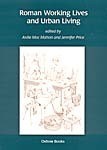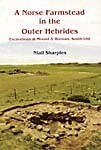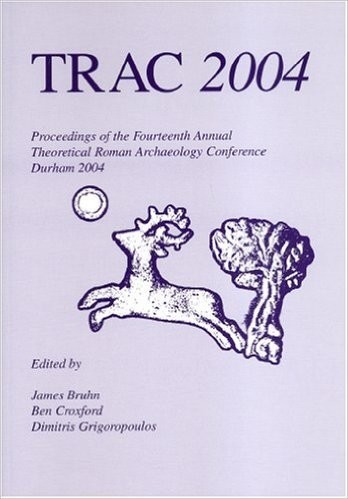Oxbow Books is a leading publisher in the fields of archaeology, ancient history and medieval studies, with an international reputation for quality and affordability. Oxbow's archaeology publishing covers all periods from earliest prehistory through classical archaeology, the ancient Near East, Egyptology, the Middle Ages and post-medieval archaeology. They publish a wide variety of books including scholarly monographs, edited collections of papers, and excavation and research reports in related fields such as archaeological practice and theory, archaeozoology, and environmental, landscape and maritime archaeology.
Founded in Oxford in 1983 by academic and museum archaeologist, David Brown, Oxbow Books has evolved and expanded significantly over the years. Now celebrating their 40th anniversary, Oxbow remains dedicated to the quality of their publishing for readers, and the contribution their books bring to the scholarly and professional communities more broadly.

Format: Paperback
ISBN: 9781842171615
Pub Date: 31 Dec 2005
Series: ASTENE Publications
Description:
Contents: Introduction ( Sarah Searight ); Travelling to post: Lady Liston, an ambassadress in Constantinople ( Deborah Manley ); Two feisty ladies in the Levant: Princess Caroline and Lady Craven ( Charles Plouviez ); Travels in the Slavonic provinces of Turkey-in-Europe: Miss Muir Mackenzie and Miss Irby ( Dorothy Anderson ); Three travellers in nineteenth-century Egypt: Sarah Belzoni, Amelia Edwards and Margaret Benson ( Megan Price ); Lucie Duff Gordon: a woman's perception of Egypt ( Sarah Searight ); Governess to the Grand Pasha of Egypt: Emmeline Lott ( Alix Wilkinson ); The unknown pilgrimage to Sinai ( Deborah Manley ); Archaeologists' wives as travel writers ( Elizabeth French ); Women's perceptions of, and perceptions of women in, Egypt's Eastern desert ( Janet Starkey ).

Format: Hardback
Pages: 218
ISBN: 9781842171684
Pub Date: 05 Oct 2005
Series: Levant Supplementary Series
Description:
The eastern Mediterranean was the centre of trade for many centuries, sitting at the junction of what are now Europe, Asia and Africa. It was the place where exotic produce and products could be traded or exchanged for things that had their origins perhaps thousands of miles away. But wherever trade takes place, a similar exchange of ideas, technology and culture also occurs.
This book presents thirty papers on this very subject, looking at the ways in which we can measure the transmission of culture, and how this transmission varied across time and space.

Format: Paperback
Pages: 166
ISBN: 9781842171448
Pub Date: 06 Sep 2005
Series: Symposia of the Association for Environmental Archaeology
Description:
The fourteen papers in this volume focus on the environmental archaeology of Britain, uncovering a rich seam of evidence from what might, to the uninitiated, seem like the most unlikely places. They are centred on issues looked at by Susan Limbrey during her career, and presented in her honour on the occasion of her retirement.

Format: Paperback
Pages: 232
ISBN: 9781842171868
Pub Date: 18 Aug 2005
Illustrations: b/w illus, 2 maps
Description:
The ordinary people who made up the largest section of the population in the cities and towns in the Roman world were largely ignored by contemporary writers and have often been marginalised in traditional studies of Roman urbanism, but research into their patterns of work and social interaction have increased markedly in recent years. This book has come out of a conference on 'Roman Working Lives and Urban Living' held at the University of Durham in 2001. The conference was planned as a forum for people researching urban space and architecture, commercial and retail structures, organisation of craft activity and social theory.
The twelve papers presented here have been organised into two categories: Urban living and the settings for working lives and People at work: Owners, and artisans, crafts and professions . The range of topics and variety of approaches in the papers emphasise the wealth of the material available, and it is hoped that this will stimulate further research into the lives of the 'silent voices' of Roman urban society.

Format: Paperback
Pages: 224
ISBN: 9781842172001
Pub Date: 05 Aug 2005
Illustrations: 86 b/w illus and pls
Description:
The term 'Mesolithic' was born in the nineteenth century from the need to label a 'hiatus' period and was not generally accepted as a useful term by many scholars until around fifty years later. It has been championed by some, but still concerns others because of the difficulty of defining what it represents. This volume highlights the enthusiasm for Mesolithic studies in the 21st century and the feeling that there is a need to explore the many facets of Mesolithic lifeways.
Approaches are now moving away from the traditional Mesolithic canon that seems to have been based on a particular set of biological and/or ecological perspectives and are now looking for new directions and new theoretical arenas which can only help stimulate Mesolithic debate. The papers in this volume take a range of approaches to a period that has largely been devoid of explicit theoretical discussion. They deconstruct and explore a broad variety of subjects, including mobility, complexity, seasonality, death & burial, gender & sexuality, social relations, music, human agency, ethnoarchaeology and emotion.

Format: Hardback
Pages: 304
ISBN: 9781842171486
Pub Date: 10 May 2005
Description:
In 1998 Anna Marguerite McCann received the Gold Medal of the Archaeological Institute of America for her distinguished archaeological achievements. This volume includes the papers presented at a special colloquium held in her honour, along with essays by other colleagues and friends. The volume is divided into two thematic parts: the first reflects Anna McCann's general interests in ancient art and archaeology, especially Greek and Roman sculpture; the other, her specific expertise in underwater and port archaeology and technology.

Format: Hardback
Pages: 224
ISBN: 9781842171691
Pub Date: 30 Apr 2005
Description:
This volume examines South Uist, a small island in the soutern half of the Outer Hebrides. In the middle of the island lies the township of Bornais. This covers a particularly flat area of land which means that the three mounds can be seen all the more clearly.
These mounds have been identified as being from the Viking period, with evidence of pre-Viking habitation at the site coming from Iron Age sherds. The excavation of the Bornais settlement is a long-term project, which has been going since 1994. This first volume of results of the excavation focuses on Mound 3, but includes a discussion of the topographic and geophysical survey of all the mounds. There is also considerable analysis of the environmental remains and radiocarbon dating.

Format: Hardback
Pages: 414
ISBN: 9781842171493
Pub Date: 19 Apr 2005
Series: Urban Archaeological Assessment
Illustrations: 6 plans, 12 tables, 156 figs
Description:
St Albans has a long tradition of archaeological investigation dating back to the 18th century. What has been lacking however, is a detailed synthesis and interpretation of the accumulated information. This book is intended to meet that need, and comes out of a project set up by English Heritage in 1992 designed to promote 'intensive' urban archaeological strategy.
This volume is a critical assessment of the current archaeological information from an area of 12 square kilometers centred on medieval and modern St Albans and its Roman predecessor, Verulamium. There is evidence of scattered occupation in the area from the Mesolithic period onwards, but it was only towards the end of the 1st century BC that a settlement was established to the south of the modern town. This was superseded by the development of the Roman town of Verulamium on the south side of the River Ver, but by the 8th century settlement had become focused on the shrine of the late Roman martyr, Alban, on the hill to the north of the river. In the late Saxon period an Abbey was established close to this shrine, and after the Norman conquest, settlement concentrated in the area north of the Abbey. Most of the monastic buildings were demolished shortly after the dissolution of the monastery in 1539, but on the whole St Albans retained its medieval form until the 19th century. The papers in this volume look at the development of this important city throughout its long history, bringing its Roman and Medieval past to life.

Format: Paperback
Pages: 192
ISBN: 9781842171653
Pub Date: 15 Apr 2005
Illustrations: b/w illus
Description:
The recent renaissance of interest in the history of dress and its cultural importance is celebrated in this collection of interdisciplinary essays. The sixteen contributors present on-going research into the study of the clothed body in ancient Egypt and the Aegean, Classical Greece, Rome and Late Antiquity. Through literary and artistic evidence and film, they discuss how dress articulates and defines an individual within his or her given society, at the same time highlighting common themes in scholarship, methodological differences between disciplines and periods, as well as contrasting definitions of what constitutes the clothed body.
Essays discussing Aegean Bronze Age fashions, costume design in filmed biblical epics, clothing in Aristophanic comedy, Greek and Roman female undergarments, the symbolism of the Roman toga, and the spectacle of images of Byzantine dress, are just some of the diverse subjects covered in this study.

Format: Paperback
Pages: 128
ISBN: 9781842171431
Pub Date: 11 Mar 2005
Illustrations: b/w illus
Description:
As its title might suggest, this volume sets out to present a new view of Scotland's Neolithic as seen via its monumental structures. The papers brought together here came out of a research day at Cardiff University's School of History and Archaeology in January 2002 and cover a diverse number of topics. They raise questions of ancestry and worldview, and highlight the amount that can be done in examining the settings of monuments.


Pages: 176
ISBN: 9781842171189
Pub Date: 25 Feb 2005
Series: Proceedings of the 9th ICAZ Conference
Pages: 160
ISBN: 9781785704604
Pub Date: 15 Oct 2016
Series: Proceedings of the 9th ICAZ Conference
Description:
Taphonomic studies are a major methodological advance, the effects of which have been felt throughout archaeology. Zooarchaeologists and archaeobotanists were the first to realise how vital it was to study the entire process of how food enters the archaeological record, and taphonomy brought to a close the era when the study of animal bones and plant remains from archaeological sites were regarded mainly as environmental indicators.This volume is indicative of recent developments in taphonomic studies: hugely diverse research areas are being explored, many of which would have been totally unforeseeable only a quarter of a century ago.

Format: Paperback
Pages: 168
ISBN: 9781842171400
Pub Date: 15 Jan 2005
Series: Journal of Roman Pottery Studies
Description:
Contents: The Study Group for Roman Pottery Research framework document for the study of Roman pottery in Britain, 2003 (Steven Willis); A large group of 2nd-century pottery from Ironmonger Lane, in the City of London: IRL 95, context 58 (R P Symonds et al); Quantifying status: some pottery data from the Upper Thames Valley (Paul Booth); Can you trust a correlation coefficient? (Clive Orton and Ash Rennie); The distribution and exchange of pink, grog-tempered pottery in the East Midlands: an update (Jeremy Taylor); Guidelines for the archiving of Roman pottery; The early Roman pottery industry in Cologne, Germany: a new kiln site in the Oppidum Ubiorum (Maureen Carroll); A Roman pottery kiln at Abernant Farm, Caerleon, Gwent (NGR ST 3680 9140) (P V Webster, K F Hartley, A G Marvell and S H Sell); Wroxeter: after Barker, after Webster (C Jane Evans); Reviews; Obituaries; Bibliography (and index to entries).

Format: Paperback
Pages: 170
ISBN: 9781842171738
Pub Date: 01 Jan 2005
Series: TRAC
Illustrations: b/w illus, tables
Description:
The fourteenth Theoretical Roman Archaeology Conference was held at the University of Durham Department of Archaeology, March 2004. The papers present and discuss information drawn from as wide a range of geographical regions of the Roman Empire as the scope of theoretical and methodological approaches applied. An equally wide selection of subject matter is illustrated, including the ancient economy, historiography and modern perceptions of the Roman world, production, supply and consumption of material culture, social identities and the experience of social space and the landscape.
Contents: Preface; The economy of Roman Britain: Representation and historiography (Kevin Greene) ; Reconstructing syntheses in Romano-British cremation (Jake Weekes) ; Metalworking and Late Roman power: A Study of towns in Later Roman Britain (Adam Rogers) ; Not at random: Evidence for a regionalized coin supply? (Fleur Kemmers) ; Regional identities and the social use of ceramics (Martin Pitts) ; Social and economic aspects of glass recycling (Daniel Keller) ; Interaction and exchange in food production in the Nijmegen frontier area during the Early Roman period (Annemiek Robeerst) ; Brickworks and ladders: Explaining intra-regional diversity of late prehistoric and Roman landscapes in the territory of the Parisi (Mick A Atha) ; Beyond the temple: Blurring the boundaries of 'sacred space' (Eleanor Ghey) ; The cupae of Iberia in their monumental contexts: A study of the relationship between social status and commemoration with barrel-shaped and semi-cylindrical tombstones (Charlotte Tupman) ; The quick and the dead in the extra-urban landscape: The Roman cemetery at Ostia/ Portus as a lived environment (E J Graham) ; Houses, GIS and the micro-topology of Pompeian domestic space (Michael A Anderson) ; Unifying aspects of Roman fortresses (Mark Driessen) .


Pages: 432
ISBN: 9781842171585
Pub Date: 12 Dec 2004
Series: Butrint Archaeological Monographs
Illustrations: 88 b/w pls, 169 b/w illus, 31 col pls, 16 col illus, tbs
Pages: 432
ISBN: 9781789253436
Pub Date: 31 Dec 2019
Series: Butrint Archaeological Monographs
Illustrations: 88 b/w pls, 169 b/w illus, 31 col pls, 16 col illu
Description:
The ancient walled town of Butrint sits at the crossroads of the Mediterranean. In its heyday it could command sea-routes up the Adriatic Sea to the north, across the Mediterranean to the west, and south through the Ionian islands. It also controlled a land-route into the mountainous Balkan interior.
For much of its long history it occupied a hill on a bend in the Vivari Channel, which connects the Straits to the large inland lagoon of Lake Butrint. Designated a UNESCO World Heritage site in 1992, Butrint covers an area of around 16 ha, but geophysical survey has shown that at times it was almost twice this size. The site itself is made up of two parts: the acropolis and the lower city. The acropolis is a long narrow hill, whose sides are accentuated by a circuit of walls that separate it from the natural and artificial terraces gathered around the flanks of the hill. The lower city occupies the lower-lying contours down to the edge of the Vivari Channel. This book brings to life this extraordinary Byzantine town, with chapters on the historical sources, various aspects of the archaeological excavation and survey, finds of pottery and environmental remains.

Format: Paperback
Pages: 288
ISBN: 9781842171066
Pub Date: 15 Nov 2004
Series: Symposia of the Association for Environmental Archaeology
Illustrations: 101 b/w figs, 33 tbs
Description:
Maritime communications have played a vital role in shaping both human cultures and the biogeography of the North Atlantic Realm, a region containing discrete groups of islands separated by deep water. The aim of this volume is to explore the diversity of human environments and cultural adaptations present within the eastern part of the North Atlantic Realm, from Scotland and Norway in the East to Iceland in the West. The papers explore a number of key themes, including: the origins of flora and fauna of the North Atlantic Realm and the introduction of non-indigenous species in post-glacial periods; the various stages of human colonisation, from the explorations of Mesolithic hunter-gatherers in the Hebridean islands to the Norse settlement of the Faroes, Iceland and Greenland during the 8th to 10th centuries AD, and how each stage of colonisation has had its own ecological characteristics and consequences for indigenous flora and fauna; the influence of climatic variability and extreme episodic events on local environments and human settlement patterns; and the establishment and development of human exchange and trade networks and how they have affected the range of resources available for human exploitation, from agricultural domesticates to the development of the Flemish sea fishery.
These papers were presented at the first joint meeting of the Association for Environmental Archaeology (AEA) and the North Atlantic Bio-cultural Organisation (NABO), which was held at Glasgow University in March 2001.

Format: Paperback
Pages: 238
ISBN: 9781842171554
Pub Date: 11 Nov 2004
Illustrations: 62 b/w illus, 17 tabs
Description:
Few areas of the world have played as prominent a role in human evolution as the Levantine Corridor, a comparatively narrow strip of land sandwiched between the Mediterranean Sea on the west and the expanse of inhospitable desert to the east. The first hominids to leave Africa, over 1.5 million years ago, first entered the Levant before spreading into what is now Europe and Asia.
About 100,000 years ago another African exodus, this time of anatomically modern humans, colonised the Levant before expanding into Eurasia. Toward the end of the Pleistocene, this Corridor also witnessed some of the earliest steps toward economic and social intensification, perhaps the most radical change in hominid lifestyle that ultimately paved the way for sedentary communities wholly dependent on domestic animals and cultivated plants.




















